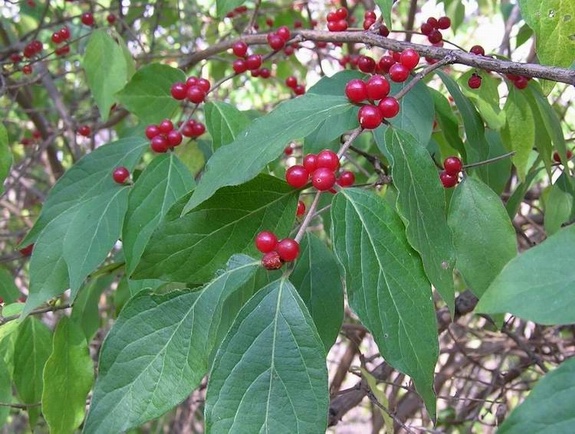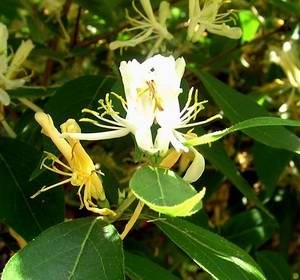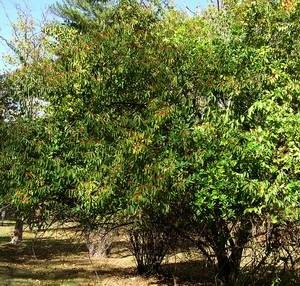|
Return to Hiker's Notebook Home Page
Common Name: Honeysuckle, Bush honeysuckle, Honeysuckle bush, Woodbine (England), Goat's leaf, Ch�vre-feuille (French), Geisblatt (German) - From the Middle English words hunig, meaning honey and sucan, meaning to suck; the flower of the plant has honey-sweet nectar that is either sucked out by long-tongued insects in situ or by humans from the base after detaching the blossom from the calyx.
Scientific Name: Lonicera spp and Diervilla spp - The genus of non-native bush honeysuckles Lonicera was named in recognition of Adam Lonitzer (1528-1586), a noted German herbalist and author of Naturalis Historiae Opus Novum; the genus of the native bush honeysuckles Diervilla recognizes a French doctor named Dierville who introduced the shrubs of this genus to Europe from North America in the late 17th Century.
The honeysuckle gives its name to the family Caprifoliaceae which consists of some fifteen genera and 400 species predominantly found in the temperate areas of both the northern and southern hemispheres, though there are representatives in the Himalayas and North Africa. Caprifoliaceae means literally "goat's leaf;" certain honeysuckles are favored by goats - the alternative common name goat's leaf in English and French (Ch�vre-feuille) attests to this association. The honeysuckle (Lonicera) and bush honeysuckle (Diervilla) genera include about 200 species world-wide with a concentration of about 100 species in China. The plants of the honeysuckle family are mostly shrubs like the bush honeysuckles but may also be vines and herbs. The non-native bush honeysuckles are considered invasive weeds in some areas; a pejorative designation for opportunistic plants that readily propagate in the absence of any natural faunal or fungal control agents. The success of the honeysuckle species is due to a number of factors. They produce copious flowers whose fragrance is only surpassed by the sweetness of the nectar in attracting pollinators; the common name honeysuckle is apt. The consequence of the pollination is the production of abundance berries, which, though mildly poisonous to humans, are highly regarded by birds, who dutifully and unwittingly spread the seeds; it is common to find bush honeysuckle seedlings under the trees used by birds as perch (and defecation) areas. There is some evidence that the honeysuckle is allelopathic, it produces a chemical that permeates the soil in the immediate vicinity that is toxic to competing species. Lastly, the bush honeysuckles have a long period of verdancy, leafing out early in the spring to maintain a canopy until November, the resultant shade restricting the germination of competitors.
Some honeysuckles are reputed to have beneficent medicinal properties, notably the vinous Japanese honeysuckle (L. japonica). However, the Eurasian honeysuckles are not without their adherents. The Elizabethan herbalist Nicholas Culpepper wrote in his Complete Herbal (1653) that "It is fitting a conserve made of the (honeysuckle) flowers should be kept in every gentlewoman's house; I know no better cure for the asthma than this besides it takes away the evil of the spleen: provokes urine, procures speedy delivery of women in travail, relieves cramps, convulsions, and palsies, and whatsoever griefs come of cold or obstructed perspiration; if you make use of it as an ointment, it will clear the skin of morphew, freckles, and sunburnings, or whatever else discolors it, and then the maids will love it." There is no modern medical evidence to support these assertions. |


 The
species and common names of the Lonicera genus bush honeysuckles were
assigned according to their provenance. L. tatarica or Tartarian
(sometimes Tatarian) honeysuckle is native to Tatary, an indefinite region in
Eurasia that extends from the Sea of Japan to the Dnieper River. Tartarian
honeysuckle wood is widely used in the manufacture of toys for cats; it
contains nepetalactone, the primary ingredient in catnip. Amur honeysuckle (L.
maackii for the Russian naturalist Richard Maack) is found in the eastern
part of Eurasia; the Amur River comprises most of the border between Russia
and China. It is one of the primary sources of honeysuckle oil, a popular
herbal unguent. Both Tartarian and Amur honey suckle were introduced to North
America, the former in 1752, the latter in 1855, as a means of erosion control
of waste areas and to created hedge boundaries.
The
species and common names of the Lonicera genus bush honeysuckles were
assigned according to their provenance. L. tatarica or Tartarian
(sometimes Tatarian) honeysuckle is native to Tatary, an indefinite region in
Eurasia that extends from the Sea of Japan to the Dnieper River. Tartarian
honeysuckle wood is widely used in the manufacture of toys for cats; it
contains nepetalactone, the primary ingredient in catnip. Amur honeysuckle (L.
maackii for the Russian naturalist Richard Maack) is found in the eastern
part of Eurasia; the Amur River comprises most of the border between Russia
and China. It is one of the primary sources of honeysuckle oil, a popular
herbal unguent. Both Tartarian and Amur honey suckle were introduced to North
America, the former in 1752, the latter in 1855, as a means of erosion control
of waste areas and to created hedge boundaries.